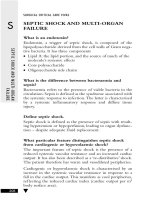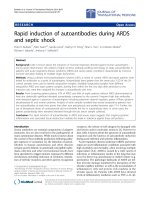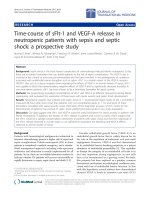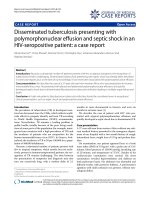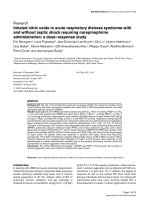Septic Shock and Multi-Organ Failure
Bạn đang xem bản rút gọn của tài liệu. Xem và tải ngay bản đầy đủ của tài liệu tại đây (202.85 KB, 17 trang )
S
SEPTIC SHOCK AND MULTI-ORGAN
FAILURE
SEPTIC SHOCK AND MULTI-ORGAN
FAILURE
What is an endotoxin?
Endotoxin, a trigger of septic shock, is composed of the
lipopolysaccharide derived from the cell walls of Gram nega-
tive bacteria. It has three components
᭹
Lipid A: the lipid portion, and the source of much of the
molecule’s systemic effects
᭹
Core polysaccharide
᭹
Oligosaccharide side chains
What is the difference between bacteraemia and
sepsis?
Bacteraemia refers to the presence of viable bacteria in the
circulation. Sepsis is defined as the syndrome associated with
the systemic response to infection. The latter is characterised
by a systemic inf lammatory response and diffuse tissue
injury.
Define septic shock.
Septic shock is defined as the presence of sepsis with result-
ing hypotension or hypoperfusion, leading to organ dysfunc-
tion – despite adequate f luid replacement.
What particular feature distinguishes septic shock
from cardiogenic or hypovolaemic shock?
The important feature of septic shock is the presence of a
reduced systemic vascular resistance and an increased cardiac
output. It has also been described as a ‘re-distributive’ shock.
The patient therefore has warm and vasodilated peripheries.
Cardiogenic or hypovolaemic shock is characterised by an
increase in the systemic vascular resistance in response to a
fall in the cardiac output. This manifests as cool peripheries,
ref lecting the reduced cardiac index (cardiac output per m
2
body surface area).
SURGICAL CRITICAL CARE VIVAS
᭢
208
What is the systemic inflammatory response
syndrome (SIRS)?
The SIRS is the syndrome arising from the body’s reaction
to critical illness, such as overwhelming infection or trauma.
Its presence is recognised and defined according to a number
of clinical criteria
᭹
Temperature of Ͼ38°C or Ͻ36°C
᭹
Heart rate of Ͼ90/min
᭹
Respiratory rate of Ͼ20/min, or PaCO
2
of Ͻ32 mmHg
(4.3 kPa)
᭹
White cell count of Ͼ12,000 or Ͻ4,000 or greater than
10% immature forms
What triggers SIRS?
Triggers include
᭹
Sepsis
᭹
Multiple trauma
᭹
Burns
᭹
Acute pancreatitis
Thus many conditions other than sepsis may trigger these
features. The concept of SIRS was introduced after it was
shown that less than 50% of those who exhibited features of
sepsis had positive blood cultures.
What are the basic pathophysiological events that
lead to the development of SIRS?
The pathophysiology of this condition involves a progressive
increase in the distribution of the inf lammatory response in
the body. The basic problem is a situation where the inf lam-
matory response to the triggering event is excessive or
poorly regulated. It has been described in terms of three
phases
᭹
Phase I: There is a local acute inf lammatory response
with the chemotaxis of neutrophil polymorphs and
macrophages. Inf lammatory mediators (such as cytokines
and proteases) are released
SURGICAL CRITICAL CARE VIVAS
S
᭢
209
SEPTIC SHOCK AND MULTI-ORGAN
FAILURE
S
SEPTIC SHOCK AND MULTI-ORGAN
FAILURE
᭹
Phase II: These mediators are systemically distributed.
Normally anti-inf lammatory mediators such as IL-10
ensure that the systemic response is limited
᭹
Phase III: An overwhelming systemic cytokine ‘storm’ leads
to the recognised systemic outcomes – pyrexia, tachycardia,
peripheral vasodilatation and increased vascular
permeability. There is a catabolic state with reduced tissue
oxygen delivery despite increased oxygen demand
Name some important mediators that have been
implicated in the development of SIRS.
᭹
IL-1: induces pyrexia and leucocyte activation
᭹
IL-6: involved in the acute phase response
᭹
IL-8: involved in neutrophil chemotaxis
᭹
Platelet activating factor (PAF): induces leucocyte activation
and increased capillary permeability
᭹
Tumour necrosis factor alpha (TNF-␣): a pyrogen that
stimulates leucocytes
Have you heard of the ‘two-hit’ hypothesis in the
development of SIRS?
Yes, this is the observed finding that those with SIRS who are
recovering can have a rapid systemic response to a seemingly
trivial second insult, such as a urinary tract or line infection.
This may lead to a rapid and terminal deterioration in the
patient’s state.
Define the multi-organ dysfunction syndrome
(MODS).
The MODS is defined as the presence of altered and poten-
tially reversible organ function in an acutely ill patient such
that homeostasis cannot be maintained without intervention.
By definition it affects two or more organs.
There are two types
᭹
Primary MODS: the organ failure is directly attributable
to the initial insult
SURGICAL CRITICAL CARE VIVAS
᭢
210
᭹
Secondary MODS: the failure occurs as a result of the
effects of SIRS. There may be a latent period between the
initial event and the subsequent organ failure
Which organ systems may be involved in this process?
Any organ system may potentially be involved
᭹
Cardiovascular system: there is vasodilatation with
microcirculatory changes that increase the capillary
permeability. This leads to a reduction of the systemic
vascular resistance and maldistribution of blood f low.
Initially there is a hyperdynamic state with increased
cardiac output. Later, there is myocardial suppression
᭹
Lungs: there is acute lung injury progressing to ARDS.
This presents as pulmonary oedema, leading to V/Q
mismatch and respiratory failure
᭹
Acute renal failure due to acute tubular necrosis
᭹
Gut: there is an ileus and intolerance to enteral feeding.
Translocation of bacteria across the gut wall perpetuates
sepsis
᭹
Liver leading to deranged liver function
᭹
Coagulopathy due to systemic activation of the coagulation
cascade. This can lead to disseminated intravascular
coagulation
᭹
Others: such as bone marrow failure and neurological
disturbances
Why may the gut fail in these situations?
There are a number of reasons
᭹
The mucosa, which is very sensitive to ischaemia loses its
integrity and function
᭹
Exacerbated by maldistribution of blood f low
᭹
Alterations in the number and type of gut f lora
What is the mortality associated with organ failure?
᭹
Mortality from renal failure is around 8%
᭹
Mortality from renal failure ϩone other organ is around 70%
᭹
Mortality from three failing organs is around 95%
SURGICAL CRITICAL CARE VIVAS
S
᭢
211
SEPTIC SHOCK AND MULTI-ORGAN
FAILURE
S
SEPTIC SHOCK AND MULTI-ORGAN
FAILURE
What are the basic principles of management of any
case of SIRS and MODS?
Management place a heavy emphasis on support of the fail-
ing organ systems
᭹
Surgical intervention: sometimes required to reduce the
infective load onto the circulation, e.g. drainage of pus
᭹
Circulatory support: to maintain the cardiac index and
oxygen delivery to the tissues with the use of i.v. f luids.
Inotropes may be required, e.g. norepinephrine to
increase the systemic vascular resistance. Monitoring
therefore involves the insertion of a pulmonary artery
f lotation catheter
᭹
Ventilatory support for the management of ARDS and
respiratory failure. Note the risk of nosocomial
pneumonia from intubation or aspiration
᭹
Renal support: to ensure that the urine output is
Ͼ0.5 ml/kg/h. Dopamine or a furosemide infusion may
be required to support the failing kidney. Cardiac support
helps maintain the renal perfusion pressure. Renal
replacement therapies (haemofiltration, haemodialysis, and
peritoneal dialysis) may also be required
᭹
Nutritional support: may be enteral or parenteral. Enteral
nutrition helps maintain mucosal integrity and reduce
bacterial translocation
᭹
Systemic antibiotics and infection surveillance. Initially,
chemotherapy is empirical, but ultimately depends on
culture results
SURGICAL CRITICAL CARE VIVAS
212
SODIUM AND WATER BALANCE
What is the distribution of sodium in the body?
Sodium is the major extracellular cation of the body
᭹
50% is found in the extracellular f luid
᭹
45% is found in the bone
᭹
5% in the intracellular compartment
The vast majority (~70%) is found in the readily exchangeable
form.
What are the major physiological roles of
sodium?
Because of the content of sodium in the body, it exerts sig-
nificant osmotic forces, and so important for internal water
balance between the intra and extracellular compartments.
It also has a role in determining external water balance and
the extracellular f luid volume. The other important role
of sodium is in generating the action potential of excitable
cells.
What is the daily sodium requirement?
The daily requirement is about 1 mmol/kg/day.
What is the normal plasma concentration?
The normal is 135–145 mmol/l.
Give a simple classification of the causes of
hyponatraemia.
᭹
Water excess
Increased intake: polydipsia, iatrogenic, e.g. TURP
syndrome, excess dextrose administration
Retention of water: SIADH
Retention of water and salt: nephrotic syndrome, cardiac
and hepatic failure
SURGICAL CRITICAL CARE VIVAS
S
᭢
213
SODIUM AND WATER BALANCE
